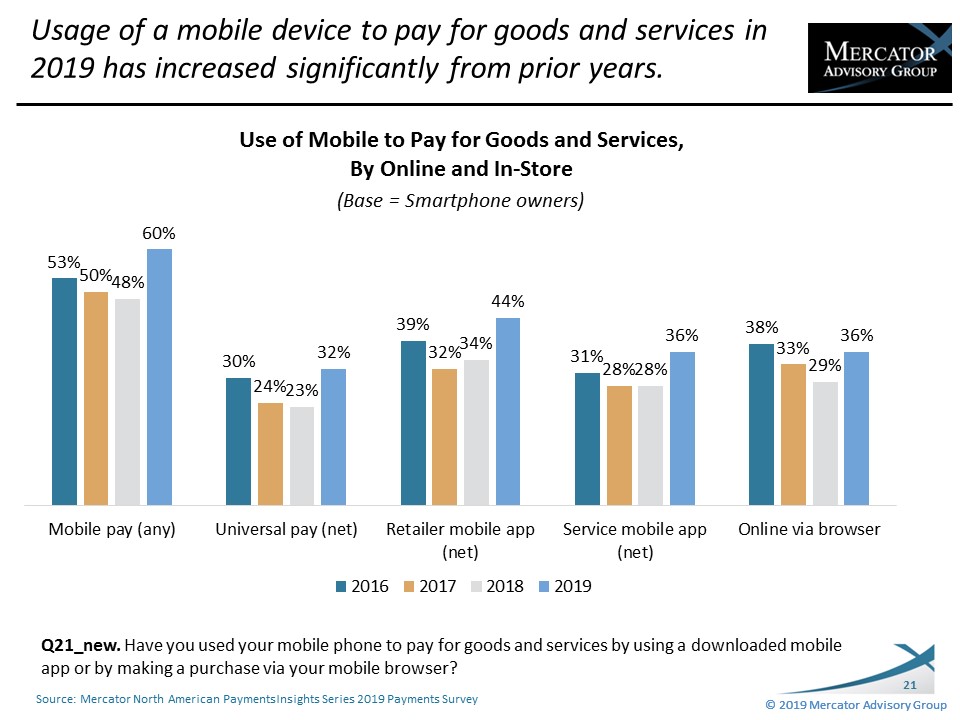Mobile Payments: Making a Comeback
- Date:October 31, 2019
- Author(s):
- Peter Reville
- Research Topic(s):
- North American PaymentsInsights
- PAID CONTENT
Overview
Mercator Advisory Group’s most recent consumer survey report, Mobile Payments: Making a Comeback, from the bi-annual North American PaymentsInsights series, reveals that the use of mobile wallets by U.S. consumers has rebounded to 2016 levels or higher after a two-year decline.
The use of any mobile payment has increased from 48% in 2018 to 60% in 2019. In comparison, in 2016 53% reported using a mobile wallet. Similar findings are seen when usage of universal mobile payment and digital services wallets like Apple Pay and Google Pay is separated from usage of retailer-specific wallets like those of Starbucks and Walmart.
Online service providers with built-in payments like Uber and Airbnb have also seen impressive growth from 2018 (36% vs 28%).
Mobile is increasingly becoming a major part of consumer shopping in the U.S. Six in 10 report either browsing or shopping via mobile device in 2019. Mobile shopping is much more common among younger adults than others. For example, 57% of consumers 18 to 34 years or age have purchased a product or services through their smartphone compared to 19% of those 65 or older.
The use of conversational interfaces through a device like a smartphone or smart speaker is currently relatively low. Two in 10 (22%) use the conversational interface on their smartphone and about 1 in 10 (12%) are using a smart speaker. The use of these interfaces for payment transactions (bill pay, ordering food, and purchasing goods and services) still has room to grow.
Mobile Payments: Making a Comeback, the latest report from Mercator Advisory Group’s Primary Data Service, is based on a sample of 3,002 U.S. adults surveyed in the annual online Payments survey of Mercator’s North American PaymentsInsights series, conducted in June 2019.
The study highlights consumers’ use and interest in mobile devices, the use of mobile wallets, how people use mobile wallets to shop, and the use of conversational interfaces.
“There was a lot of hype around the release of mobile wallets a few years ago and, once people started using them, they may have encountered spotty acceptance of mobile payments and app difficulties and stopped using them. We are seeing a resurgence of usage in 2019 with increased acceptance at the point of sale, increased online use, and increased customer comfort,” stated the author of the report, Peter Reville, director of Primary Data Services at Mercator Advisory Group, which includes the North American PaymentsInsights series.
This report in slide form is 55 pages long.
Companies mentioned in the survey results shown include: Airbnb, Amazon, Apple, Booker, Chase, Fandango, Google, Lyft, OpenTable, Samsung, Uber, and Wells Fargo.
One of the exhibits included in this report:

Highlights of this report include:
- Reported smartphone ownership over time
- Passwords and other methods for unlocking mobile devices
- Cards loaded into the mobile wallet – credit, debit, prepaid
- Frequency of the number of mobile payments made
- Awareness and usage of the prepaid card websites available
- Motivators to mobile wallet usage
- Comparison of mobile wallets to plastic
- Shopping with mobile
- The use of order-ahead services
- The use of conversational interfaces.
- Paying for things with a voice interface
Book a Meeting with the Author
Related content
A Generational Look at Card Network Usage
In this Primary Data Snapshot by Javelin Strategy & Research, a dive into year-over-year usage of the four major U.S. credit card networks shows that generationally targeted approa...
The Bots are Coming: Generational Aspects to AI Adoption
This Primary Data Snapshot—a Javelin Strategy & Research report focusing on consumer payment usage and behavior—shows how consumers, particularly younger ones, are leveraging the p...
2025 North American PaymentInsights: U.S.: Financial Services and Emerging Technologies Exhibit
This report is based on Javelin Strategy’s North American PaymentsInsights series’ annual survey. A web-based survey was fielded between July 14 – 26, 2025, using a US online consu...
Make informed decisions in a digital financial world